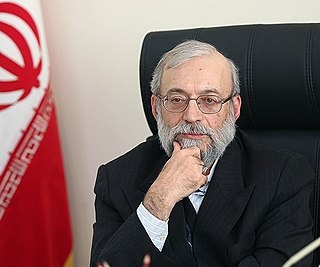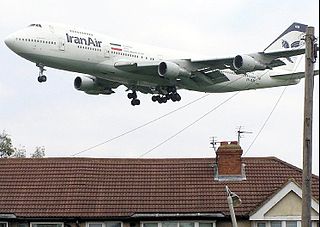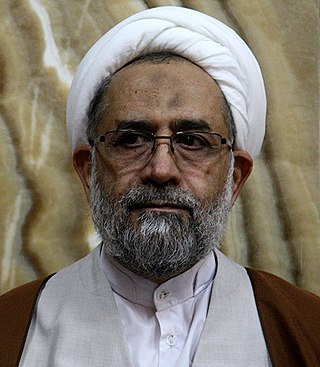Contents
| |||||
| Decades: | |||||
|---|---|---|---|---|---|
| See also: | Other events of 2018 Years in Iran | ||||
Events in the year 2018 in Iran .
| |||||
| Decades: | |||||
|---|---|---|---|---|---|
| See also: | Other events of 2018 Years in Iran | ||||
Events in the year 2018 in Iran .



Seyyed Ali Hosseini Khamenei is an Iranian Twelver Shia marja' and politician who has served as the second Supreme Leader of Iran since 1989. He previously served as the third president of Iran from 1981 to 1989. Khamenei's 35-year-long rule makes him the longest-serving head of state in the Middle East, as well as the second-longest-serving Iranian leader of the last century after Shah Mohammad Reza Pahlavi.

Mohammad-Javad Ardeshir Larijani is an Iranian conservative politician and former diplomat. He is currently a top adviser to the Ayatollah Ali Khamenei in foreign affairs and secretary of High Council for Human rights, Judiciary of Islamic Republic of Iran.

Death to America is an anti-American political slogan widely used in North Korea, Iran, Afghanistan, Lebanon, Yemen, Iraq, and Pakistan. Originally used by North Korea since the Korean War, Ruhollah Khomeini, the first supreme leader of Iran, popularized the term. He opposed the chant for radio and television, but not for protests and other occasions.

Sadeq Ardeshir Larijani, better known as Amoli Larijani, is an Iranian scholar, conservative politician, and current chairman of Expediency Discernment Council. He is the former and fifth Chief Justice of the judicial system of Iran after the 1979 revolution.

One of the most dramatic changes in government in Iran's history was seen with the 1979 Iranian Revolution where Shah Mohammad Reza Pahlavi was overthrown and replaced by Ayatollah Ruhollah Khomeini. The authoritarian monarchy was replaced by a long-lasting Shiite Islamic republic based on the principle of guardianship of Islamic jurists,, where Shiite jurists serve as head of state and in many powerful governmental roles. A pro-Western, pro-American foreign policy was exchanged for one of "neither east nor west", said to rest on the three "pillars" of mandatory veil (hijab) for women, and opposition to the United States and Israel. A rapidly modernizing capitalist economy was replaced by a populist and Islamic economy and culture.

The United States has since 1979 applied various economic, trade, scientific and military sanctions against Iran. United States economic sanctions are administered by the Office of Foreign Assets Control (OFAC), an agency of the United States Department of the Treasury. As of 2017, United States sanctions against Iran include an embargo on dealings with the country by the United States, and a ban on selling aircraft and repair parts to Iranian aviation companies.

Since the Iranian Revolution in 1979, the Islamic Republic of Iran has been embroiled in tense relations with the U.S. and its allies. Following the hostage crisis, both countries severed relations. Since then, both countries have been involved in numerous direct confrontations, diplomatic incidents, and proxy wars throughout the Middle East, which has caused the tense nature of the relationship between the two to be called an 'international crisis'. Both countries have often accused each other of breaking international law on several occasions. The U.S. has often accused Iran of sponsoring terrorism and of illegally maintaining a nuclear program, as well as using strong rhetoric against Israel, of which Iran has questioned its legitimacy and its right to exist while supporting Hamas, an antizionist terrorist group in the Gaza Strip. Meanwhile, Iran has often accused the U.S. of human rights violations and of meddling in their affairs, especially within the Iranian Democracy Movement.

Heydar Moslehi is an Iranian cleric and politician who served as the minister of intelligence from 2009 to 2013.
Events in the year 2009 in the Islamic Republic of Iran.
Events in the year 2011 in the Islamic Republic of Iran.
Events in the year 2012 in the Islamic Republic of Iran.

The 16th Summit of the Non-Aligned Movement was held from 26 to 31 August 2012 in Tehran, Iran. The summit was attended by leaders of 120 countries, including 24 presidents, 3 kings, 8 prime ministers and 50 foreign ministers.
The following lists events that happened during 2013 in the Islamic Republic of Iran.

The Execution of Imam Khomeini's Order (EIKO), also known as the Executive Headquarters of Imam's Directive or simply Setad, is a parastatal organization in the Islamic Republic of Iran, under direct control of the Supreme Leader of Iran. It was created from thousands of properties confiscated in the aftermath of the 1979 Islamic Revolution. A Reuters investigation found that the organization built "its empire on the systematic seizure of thousands of properties belonging to ordinary Iranians", also seizing property from members of religious minorities, business people and Iranians living abroad; at times falsely claiming that the properties were abandoned.

The 2018–2019 Iranian general strikesand protests were a series of strikes and protests that took place across Iran from early 2018 until mid-2019 against the country's economic situation, as well as the Iranian government, as part of the wider Iranian Democracy Movement.

The 2019–2020 Iranian protests, sometimes known as Bloody November or Bloody Aban, were a series of nationwide civil protests in Iran that took place in 2019 and 2020. Initially caused by a 50–200% increase in fuel prices, they occurred as part of the wider Iranian Democracy Movement, leading to calls for the overthrow of the government in Iran and Supreme Leader Ali Khamenei. The protests commenced as peaceful gatherings on the evening of 15 November but spread to 21 cities within hours, as videos of the protest circulated online, eventually becoming the most violent and severe anti-government unrest since the Iranian Revolution in 1979.

The Islamic Republic of Iran and Ukraine established formal diplomatic relations on 22 January 1992. Iran recognized Ukraine as an independent sovereign state on 25 December 1991, four months after the Ukrainian SSR issued the Act of Declaration of Independence of Ukraine amidst the dissolution of the Soviet Union. Iran has an embassy in Ukraine's Kyiv, and Ukraine has an embassy in Iran's Tehran. The two countries enjoyed a generally cordial relationship with each other until January 2020, when Iran's Islamic Revolutionary Guard Corps shot down Ukraine International Airlines Flight 752, killing all of the 176 civilians onboard.
Events in the year 2024 in Iran.